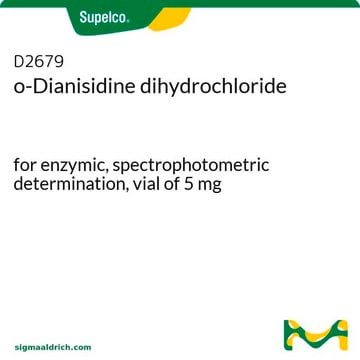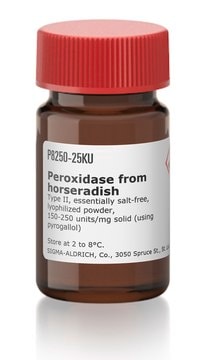D3252
o-Dianisidine dihydrochloride
≥95%
Synonyme(s) :
3,3′-Dimethoxybenzidine dihydrochloride, Fast Blue B
About This Item
Produits recommandés
Niveau de qualité
Pureté
≥95%
Forme
powder
Pf
268 °C
Solubilité
H2O: soluble 25 mg/mL
Application(s)
diagnostic assay manufacturing
hematology
histology
Température de stockage
2-8°C
Chaîne SMILES
Cl.Cl.COc1cc(ccc1N)-c2ccc(N)c(OC)c2
InChI
1S/C14H16N2O2.2ClH/c1-17-13-7-9(3-5-11(13)15)10-4-6-12(16)14(8-10)18-2;;/h3-8H,15-16H2,1-2H3;2*1H
Clé InChI
UXTIAFYTYOEQHV-UHFFFAOYSA-N
Vous recherchez des produits similaires ? Visite Guide de comparaison des produits
Catégories apparentées
Spécificité
Application
Avertissement
Forme physique
Mention d'avertissement
Danger
Mentions de danger
Classification des risques
Acute Tox. 4 Oral - Carc. 1B - Eye Dam. 1 - Skin Corr. 1
Code de la classe de stockage
6.1C - Combustible acute toxic Cat.3 / toxic compounds or compounds which causing chronic effects
Classe de danger pour l'eau (WGK)
WGK 3
Point d'éclair (°F)
Not applicable
Point d'éclair (°C)
Not applicable
Équipement de protection individuelle
Eyeshields, Gloves, type P3 (EN 143) respirator cartridges
Choose from one of the most recent versions:
Déjà en possession de ce produit ?
Retrouvez la documentation relative aux produits que vous avez récemment achetés dans la Bibliothèque de documents.
Les clients ont également consulté
Articles
NBT-BCIP substrate system aids in western blotting and immunohistological staining, producing a blue-purple insoluble end product.
Notre équipe de scientifiques dispose d'une expérience dans tous les secteurs de la recherche, notamment en sciences de la vie, science des matériaux, synthèse chimique, chromatographie, analyse et dans de nombreux autres domaines..
Contacter notre Service technique










